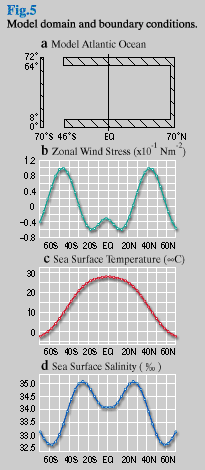The formulations (3) and (5) are applied to an ocean general circulation model (GFDL MOM2), and the entropy increase rates are calculated during a spin-up period of the model. The model domain and the boundary conditions are shown in
Fig.5. The numerical calculation is carried out for a spin-up period of 5000 years.
Fig.6 shows the formation process of the deep-water circulation cell in the North Atlantic Ocean. The circulation pattern becomes statistically steady after 4000 years. Fig.7 and 8 show the entropy increase rates of the synthetic system ( surr: the surrounding system;
surr: the surrounding system;  sys: the ocean system) due to heat transport (Fig.7) and due to salt transport (Fig.8). During the spin-up period, the entropy increase rates show rapid oscillation, but this oscillation disappears as the system reaches the steady state. At the steady state, for both heat and salt transports, the entropy increase rates of the ocean system are zero, whereas those of the surrounding system show positive values
sys: the ocean system) due to heat transport (Fig.7) and due to salt transport (Fig.8). During the spin-up period, the entropy increase rates show rapid oscillation, but this oscillation disappears as the system reaches the steady state. At the steady state, for both heat and salt transports, the entropy increase rates of the ocean system are zero, whereas those of the surrounding system show positive values
The result shows that the formation of the ocean circulation contributes to net transports of heat and salt from equatorial (hot and salty) to polar (cold and less salty) regions, and thereby increasing entropy in the synthetic part of the surrounding system. This result is consistent with the thermodynamic concept presented here. It is suggested that the existence of the ocean circulation as well as other dissipative systems in the planet is maintained by a general tendency of entropy increase in the surrounding synthetic system connected by the dissipative system.
 surr: the surrounding system;
surr: the surrounding system;  sys: the ocean system) due to heat transport (Fig.7) and due to salt transport (Fig.8). During the spin-up period, the entropy increase rates show rapid oscillation, but this oscillation disappears as the system reaches the steady state. At the steady state, for both heat and salt transports, the entropy increase rates of the ocean system are zero, whereas those of the surrounding system show positive values
sys: the ocean system) due to heat transport (Fig.7) and due to salt transport (Fig.8). During the spin-up period, the entropy increase rates show rapid oscillation, but this oscillation disappears as the system reaches the steady state. At the steady state, for both heat and salt transports, the entropy increase rates of the ocean system are zero, whereas those of the surrounding system show positive values


